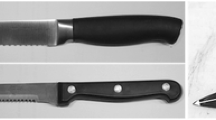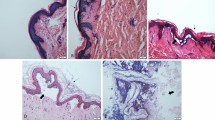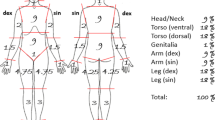Abstract
The capability of discriminating between a vital and a post-mortem injury has always been a central theme in forensic pathology, particularly when the corpse is an advanced state of decomposition. Post-mortem decay of the body can mask or disrupt the classical features of a skin lesion, making it difficult to establish the cause and manner of death. Taphonomically challenging situations pose several interpretative issues of skin lesions which need to be addressed with scientifically recent methods that are still limited in the forensic literature. For that reason, the present research aims at resuming what is currently available in the attempt to provide some insight regarding this topic. This review considers only original researches, in which the markers of vitality were studied a significant amount of time after death, in order to test post-mortem persistency of these markers over time. A number of 132 original articles and reviews were considered, and the most significant results are resumed in an overview table and in two intuitive figures. Though many researchers tried to establish the vitality of lesions in specimen, few analysed samples from bodies when a significant degree of putrefaction or burning had occurred. The most significant marker proved to be GPA, which sowed a satisfying persistence over time (up to 6 months in air putrefaction and 15 days in water). However, what clearly emerged is that further studies are needed to address the challenges of taphonomically transformed specimen and to possibly neutralize the variability of experimental conditions, which affect the reproducibility of results. In conclusion, this study could be a starting point for providing food for thoughts about the most useful markers to search for in unusually tricky autopsy cases.



Similar content being viewed by others
Data availability
The authors confirm that the data supporting the findings of this study are available within the article.
Code availability
Not applicable.
References
Cecchi R (2010) Estimating wound age: looking into the future. Int J Legal Med 124(6):523–536. https://doi.org/10.1007/s00414-010-0505-x
Saukko P, Knight B (2016) The pathophysiology of death. In: Knight’s Forensic Pathology. Saukko P, Knight B (eds) CRC Press, Boca Raton, 4th ed, Chap 2, pgg 55–94
Kibayashi K, Hamada K, Honjyo K, Tsunenari S (1993) Differentiation between bruises and putrefactive discolorations of the skin by immunological analysis of glycophorin A. Forensic Sci Int 61(2–3):111–117. https://doi.org/10.1016/0379-0738(93)90219-z
Tabata N, Morita M (1997) Immunohistochemical demonstration of bleeding in decomposed bodies by using anti-glycophorin A monoclonal antibody. Forensic Sci Int 87(1):1–8. https://doi.org/10.1016/s0379-0738(97)02118-x
Shkrum MJ, Ramsay DA (2007) Forensic pathology of trauma, common problems for the pathologist, Humana Press, Chap 2, pgg 23–64
Carter DO, Yellowlees D, Tibbett M (2007) Cadaver decomposition in terrestrial ecosystems. Naturwissenschaften 94(1):12–24. https://doi.org/10.1007/s00114-006-0159-1
Viero A, Montisci M, Pelletti G, Vanin S (2019) Crime scene and body alterations caused by arthropods: implications in death investigation. Int J Legal Med 133(1):307–316. https://doi.org/10.1007/s00414-018-1883-8
Franceschetti L, Pradelli J, Tuccia F, Giordani G, Cattaneo C, Vanin S (2021) Comparison of accumulated degree-days and entomological approaches in post mortem interval estimation. Insects 12(3):264. https://doi.org/10.3390/insects12030264
Mazzarelli D, Tambuzzi S, Maderna E, Caccia G, Poppa P, Merelli V, Terzi M, Rizzi A, Trombino L, Andreola S, Cattaneo C (2021) Look before washing and cleaning: a caveat to pathologists and anthropologists. J Forensic Leg Med 79:102137. https://doi.org/10.1016/j.jflm.2021.102137
Madea B, Doberentz E, Jackowski C (2019) Vital reactions - an updated overview. Forensic Sci Int 305:110029. https://doi.org/10.1016/j.forsciint.2019.110029
Dettmeyer RB (2011) Histopathology of selected trauma. Hemorrhage, Necrosis, and Skeletal Muscle Trauma. In: Forensic Histopathology. Fundamentals and perspectives. Dettmeyer RB (ed) Springer-Verlag Berlin Heidelberg, Chap 3.1, pgg 38–39
Janssen W (1984) Vital reactions. Hemorrhages. In: Forensic Histopathology. Janssen W (ed) Springer-Verlag Berlin Heidelberg, Chap II.2, pgg. 55–64
Dettmeyer RB (2011) Autolysis-putrefaction-histothanatology. In: Forensic Histopathology. Fundamentals and perspectives. Dettmeyer RB (ed) Springer-Verlag Berlin Heidelberg, Chap 19, pgg 401–402
Janssen W (1984) Vital reactions. Mechanically Caused Tissue Damage. In: Forensic Histopathology. Janssen W (ed) Springer-Verlag Berlin Heidelberg, Chap II.2, pgg. 66–67.
Tabata N, Funayama M, Ikeda T, Azumi J, Morita M (1995) On an accident by liquid nitrogen–histological changes of skin in cold. Forensic Sci Int 76(1):61–67. https://doi.org/10.1016/0379-0738(95)01798-4
Karger B, Lorin de la Grandmaison G, Bajanowski T, Brinkmann B (2004) Analysis of 155 consecutive forensic exhumations with emphasis on undetected homicides. Int J Legal Med 118(2):90–4. https://doi.org/10.1007/s00414-003-0426-z
Breitmeier D, Graefe-Kirci U, Albrecht K, Weber M, Tröger HD, Kleemann WJ (2005) Evaluation of the correlation between time corpses spent in in-ground graves and findings at exhumation. Forensic Sci Int 154(2–3):218–223. https://doi.org/10.1016/j.forsciint.2004.11.018
Maiese A, Del Duca F, Santoro P, Pellegrini L, De Matteis A, La Russa R, Frati P, Fineschi V (2022) An overview on actual knowledge about immunohistochemical and molecular features of vitality, focusing on the growing evidence and analysis to distinguish between suicidal and simulated hanging. Front Med 8:793539. https://doi.org/10.3389/fmed.2021.793539
Casse JM, Martrille L, Vignaud JM, Gauchotte G (2016) Skin wounds vitality markers in forensic pathology: an updated review. Med Sci Law 56(2):128–137
Manetti AC, Maiese A, Baronti A, Mezzetti E, Frati P, Fineschi V, Turillazzi E (2021) MiRNAs as new tools in lesion vitality evaluation: a systematic review and their forensic applications. Biomedicines 9(11):1731. https://doi.org/10.3390/biomedicines9111731
Legas Pérez M, Falcón M, Gimenez FM, Diaz MD, Pérez-Cárceles E, Osuna D, Nuno-Vieira AL (2017) Diagnosis of vitality in skin wounds in the ligature marks resulting from suicide hanging. Am J Forensic Med Pathol 38(3):211–218
Ortiz-Rey JA, Suárez-Peñaranda JM, Da Silva EA, Muñoz-Barús JI, San Miguel-Fraile P, De la Fuente-Buceta A, Concheiro-Carro L (2002) Immunohistochemical detection of fibronectin and tenascin in incised human skin injuries. J Forensic Sci 126:118–122
Yu-Chuan C, Bing-Jie H, Qing-Song Y, Jia-Zhen Z (1995) Diagnostic value of ions as markers for differentiating antemortem from postmortem wounds. Forensic Sci Int 75:157–162
Takamiya M, Saigusa K, Aoki Y (2002) Immunohistochemical study of basic fibroblast growth factor and vascular endothelial growth factor expression for age determination of cutaneous wounds. Am J Forensic Med Pathol 23:264–267
Girela E, Hernández-Cueto C, Lorente JA, Villanueva E (1989) Postmortem stability of some markers of intra-vital wounds. Forensic Sci Int 40(2):123–130. https://doi.org/10.1016/0379-0738(89)90139-4
Ishida Y, Kuninaka Y, Nosaka M, Shimada E, Hata S, Yamamoto H, Hashizume Y, Kimura A, Furukawa F, Kondo T (2018) Forensic application of epidermal AQP3 expression to determination of wound vitality in human compressed neck skin. Int J Leg Med 132:1375–1380
Ishida Y, Nosaka M, Shimada E, Hata S, Yamamoto H, Hasizume Y, Kimura F, Kondo T (2018) Immunohistochemical analysis on Aquaporin-1 and Aquaporin-3 in skin wounds from the aspects of wound age determination. Int J Legal Med 132:237–242
Hayashi T, Ishida Y, Kimura A, Takayasu T, Eisenmenger W, Kondo T (2004) Forensic application of VEGF expression to skin wound age determination. Int J Legal Med 118:320–325
Kondo T, Ohshima T, Eisenmenger W (1999) Immunohistochemical and morphometrical study on the temporal expression of interleukin-1α (IL-1α) in human skin wounds for forensic wound age determination. Int J Legal Med 112:249–252
Psaroudakis K, Tzatzarakis MN, Tsatsakis AM, Michalodimitrakis MN (2001) The application of histochemical methods to the age evaluation of skin wounds: experimental study in rabbits. Am J Forensic Med Pathol 22:341–345
Dressler J, Bachmann L, Kasper M, Hauck JG, Müller E (1997) Time dependence of the expression of ICAM-1 (CD 54) in human skin wounds. Int J Legal Med 110(6):299–304. https://doi.org/10.1007/s004140050092
Dressler J, Bachmann L, Koch R, Müller E (1999) Estimation of wound age and VCAM-1 in human skin. Int J Legal Med 112(3):159–162. https://doi.org/10.1007/s004140050223
Dressler J, Bachmann L, Koch R, Müller E (1998) Enhanced expression of selectins in human skin wounds. Int J Legal Med 112(1):39–44. https://doi.org/10.1007/s004140050196
Grellner W (2002) Time-dependent immunohistochemical detection of pro-inflammatory cytokines (IL1B, IL6, TNFalfa) in human skin wounds. Forensic Sci Int 130:90–96
Grellner W, Vieler S, Madea B (2005) Transforming growth factors (TGF-a and TGF-b1) in the determination of vitality and wound age: immunohistochemical study on human skin wounds. Forensic Sci Int 153:174–180
Niedecker A, Huhn R, Ritz-Timme S, Mayer F (2021) Complex challenges of estimating the age and vitality of muscle wounds: a study with matrix metalloproteinases and their inhibitors on animal and human tissue samples. Int J Legal Med 135:1843–1853. https://doi.org/10.1007/s00414-021-02563-6
Fieguth A, Kleemann WJ, von Wasielewski R, Werner M, Troger HD (1997) Influence of postmortem changes on immunohistochemical reactions in skin. Int J Legal Med 110:18–21
Butzbach DM (2010) The influence of putrefaction and sample storage on post-mortem toxicology results. Forensic Sci Med Pathol 6(1):35–45. https://doi.org/10.1007/s12024-009-9130-8
Betz P, Nerlich A, Wilske J, Tübel J, Penning R, Eisenmenger W (1993) The immunohistochemical analysis of fibronectin, collagen type III, laminin, and cytokeratin 5 in putrified skin. Forensic Sci Int 61:35–42. https://doi.org/10.1016/0379-0738(93)90247-8
Kibayashi K, Higashi T, Tsunenari S (1991) A differential study between antemortem bleeding and a postmortem infiltration of hemoglobin. Nihon Hoigaku Zasshi 45:227–232
Taborelli A, Andreola S, Di Giancamillo A, Gentile G, Domeneghini C, Grandi M, Cattaneo C (2011) The use of the anti-glycophorin A antibody in the detection of red blood cell residues in human soft tissue lesions decomposed in air and water: a pilot study. Med Sci Law 51(Suppl 1):S16–S19. https://doi.org/10.1258/msl.2010.010107
Baldari B, Vittorio S, Sessa F, Cipolloni L, Bertozzi G, Neri M, Cantatore S, Fineschi V, Aromatario M (2021) Forensic application of monoclonal anti-human glycophorin A antibody in samples from decomposed bodies to establish vitality of the injuries. A Preliminary Experimental Study Healthcare (Basel) 9(5):514. https://doi.org/10.3390/healthcare9050514
Ortiz-Rey JA, Suárez-Peñaranda JM, San Miguel P, Muñoz JI, Rodríguez-Calvo MS, Concheiro L (2008) Immunohistochemical analysis of P-selectin as a possible marker of vitality in human cutaneous wounds. J Forensic Leg Med 15(6):368–372. https://doi.org/10.1016/j.jflm.2008.02.011
Gauchotte G, Wissler MP, Casse JM, Pujo J, Minetti C, Gisquet H, Vigouroux C, Plénat F, Vignaud JM, Martrille L (2013) FVIIIra, CD15, and tryptase performance in the diagnosis of skin stab wound vitality in forensic pathology. Int J Legal Med 127(5):957–965. https://doi.org/10.1007/s00414-013-0880-1
Lesnikova I, Schreckenbach MN, Kristensen MP, Papanikolaou LL, Hamilton-Dutoit S (2018) Usability of immunohisto-chemistry in forensic samples with varying decomposition. Am J Forensic Med Pathol 39:185–191. https://doi.org/10.1097/PAF.0000000000000408
Bertozzi G, Ferrara M, La Russa R, Pollice G, Gurgoglione G, Frisoni P, Alfieri L, De Simone S, Neri M, Cipolloni L (2021) Wound vitality in decomposed bodies: new frontiers through immunohistochemistry. Front Med (Lausanne) 8:802841. https://doi.org/10.3389/fmed.2021.802841
Galloway A, Wedel VL (2014) Diagnostic criteria for the determination of timing and fracture mechanism. In: Broken Bones Anthropological Analysis of Blunt Force Trauma. Galloway A, Wedel VL (Eds) 2nd Ed. Charles C. Thomas, Publisher. Chap 4 pgg 47–58.
Cappella A, Cattaneo C (2019) Exiting the limbo of perimortem trauma: a brief review of microscopic markers of hemorrhaging and early healing signs in bone. Forensic Sci Int 302:109856. https://doi.org/10.1016/j.forsciint.2019.06.014
De Boer HH, van der Merwe AE, Hammer S, Steyn M, Maat GJR (2012) Assessing post-traumatic time interval in human dry bone. Int J Osteoarchaeol. https://doi.org/10.1002/oa.2267
Cattaneo C, Andreola S, Marinelli E, Poppa P, Porta D, Grandi M (2010) The detection of microscopic markers of hemorrhaging and wound age on dry bone: a pilot study. Am J Forensic Med Pathol 31(1):22–26. https://doi.org/10.1097/PAF.0b013e3181c15d74
Cappella A, Stefanelli S, Caccianiga M, Rizzi A, Bertoglio B, Sforza C, Cattaneo C. Blood or spores? A cautionary note on interpreting cellular debris on human skeletal remains. Int J Legal Med. 2015; 129:919-926. https://doi.org/10.1007/s00414-014-1140-8. Erratum in: Int J Legal Med. 2016 May; 130:889-890
Dammeier S, Nahnsen S, Veit J, Wehner F, Ueffing M, Kohlbacher O (2016) Mass-spectrometry-based proteomics reveals organ-specific expression patterns to be used as forensic evidence. J Proteome Res 4(15):182–192. https://doi.org/10.1021/acs.jproteome.5b00704
Tarran SL, Craft GE, Valova V, Robinson PJ, Thomas G, Markham R, Langlois NE, Vanezis P (2007) The use of proteomics to study wound healing: a preliminary study for forensic estimation of wound age. Med Sci Law 47:134–140. https://doi.org/10.1258/rsmmsl.47.2.134
Murase T, Yamamoto T, Koide A, Yagi Y, Kagawa S, Tsuruya S, Abe Y, Umehara T, Ikematsu K (2017) Temporal expression of chitinase-like 3 in wounded murine skin. Int J Legal Med 131:1623–1631. https://doi.org/10.1007/s00414-017-1658-7
He JT, Huang HY, Qu D, Xue Y, Zhang KK, Xie XL, Wang Q (2018) CXCL1 and CXCR2 as potential markers for vital reactions in skin contusions. Forensic Sci Med Pathol 14:174–179. https://doi.org/10.1007/s12024-018-9969-7
Peyron PA, Colomb S, Becas D, Adriansen A, Gauchotte G, Tiers L, Marin G, Lehmann S, Baccino E, Delaby C, Hirtz C (2021) Cytokines as new biomarkers of skin wound vitality. Int J Legal Med 135(6):2537–2545. https://doi.org/10.1007/s00414-021-02659-z
Kimura A, Ishida Y, Nosaka M, Shiraki M, Hama M, Kawaguchi T, Kuninaka Y, Shimada E, Yamamoto H, Takayasu T, Kondo T (2015) Autophagy in skin wounds: a novel marker for vital reactions. Int J Legal Med 129:537–541. https://doi.org/10.1007/s00414-015-1168-4
Xu J, Zhao R, Xue Y, Xiao H, Sheng Y, Zhao D, He J, Huang H, Wang Q, Wang H (2017) RNA-seq profiling reveals differentially expressed genes as potential markers for vital reaction in skin contusion: a pilot study. Forensic Sci Res 3:153–160. https://doi.org/10.1080/20961790.2017.1349639
Ye MY, Xu D, Liu JC, Lyu HP, Xue Y, He JT, Huang HY, Zhang KK, Xie XL, Wang Q (2018) IL-6 and IL-20 as potential markers for vitality of skin contusion. J Forensic Leg Med 59:8–12. https://doi.org/10.1016/j.jflm.2018.07.010
Author information
Authors and Affiliations
Corresponding author
Ethics declarations
Ethics approval
Not applicable.
Conflict of interest
The authors declare no competing interests.
Additional information
Publisher's note
Springer Nature remains neutral with regard to jurisdictional claims in published maps and institutional affiliations.
Rights and permissions
Springer Nature or its licensor (e.g. a society or other partner) holds exclusive rights to this article under a publishing agreement with the author(s) or other rightsholder(s); author self-archiving of the accepted manuscript version of this article is solely governed by the terms of such publishing agreement and applicable law.
About this article
Cite this article
Vignali, G., Franceschetti, L., Attisano, G.C.L. et al. Assessing wound vitality in decomposed bodies: a review of the literature. Int J Legal Med 137, 459–470 (2023). https://doi.org/10.1007/s00414-022-02932-9
Received:
Accepted:
Published:
Issue Date:
DOI: https://doi.org/10.1007/s00414-022-02932-9




